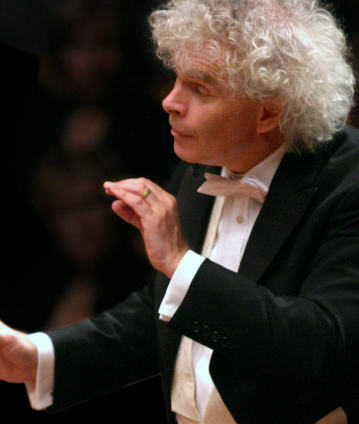Simon Rattle conducts Mahler’s Fifth Symphony

Gustav Mahler’s Fifth Symphony owes its popularity to the Adagietto, a movement full of tenderness, dreaming and hopeful longing. Yet it is easy to overlook the many facets of the other movements: the vehemence of the second and third movements, and the exuberant high spirits of the finale. The press described this performance with Simon Rattle simply as “breath-taking” and “deeply moving”.
Anyone thinking about Mahler’s Fifth Symphony automatically thinks of the Adagietto – since 1971 in any case, ever since the movement was used as the soundtrack to Luchino Visconti’s film Death in Venice, significantly contributing to the melancholy charm of the adaptation of Thomas Mann’s novella. Visconti, however, reinterprets the music, turning the Adagietto into a cipher for a farewell to life. Mahler, on the other hand, wrote this music when he had just fallen in love with Alma Schindler, who was later to become his wife. And indeed, what the unbiased listener can hear in particular in the Adagietto is tenderness, dreaming, and a sense of yearning, full of hope.
Yet Mahler would not be Mahler if he were to colour a whole symphony with one unified romantic mood. So he starts the work with a funeral march, and in the following two movements he disseminates a vehemence that is partly cataclysmic, partly dance-like. The finale culminates in buoyant mood, which may have been unusual for Mahler, yet as he composed this movement while on honeymoon with Alma in the summer of 1902, it is perhaps no surprise.
As was customary in Simon Rattle’s Mahler cycle with the Berliner Philharmoniker in 2010/11, the symphony is presented alongside a composition which demonstrates a relationship to the Mahler work. In this instance, it is the music which Henry Purcell wrote for the funeral of Queen Mary II, composed in 1695. Although we may exclude the possibility that Mahler knew Purcell’s music, the funeral march in his Fifth Symphony shows that both composers had a similar flair for the musical expression of grief.
© 2011 Berlin Phil Media GmbH
Related interviews
Artists
Our recommendations
- Vocal Heroes choir project: “The Two Fiddlers”
- Simon Rattle conducts Bruckner, Ravel and Hosokawa in Taiwan
- Simon Rattle conducts Mahler’s Fourth Symphony
- Simon Rattle conducts Mahler’s “Symphony of a Thousand”
- Simon Rattle conducts Sibelius’s Symphonies Nos. 1 and 2
- Simon Rattle conducts Beethoven’s Symphonies Nos. 1 and 3